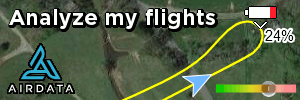It looks like the drone measures the flight altitude based on the altitude of the home point. When Iaunch my drone in a valley, 1600 ft above sea level, and I try to take images of a mountain summit which is 3000 feet high then I can only fly up to an altitude of 2000 feet? Is this correct?
If I would climb that mountain and start the drone from the top, then I should not have that problem because my home point has an altitude of 3000 feet?
If I would climb that mountain and start the drone from the top, then I should not have that problem because my home point has an altitude of 3000 feet?









